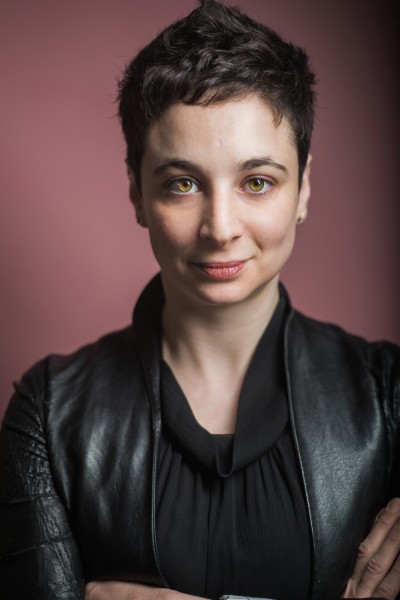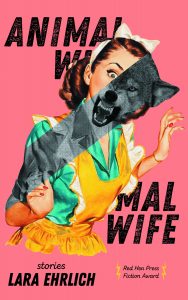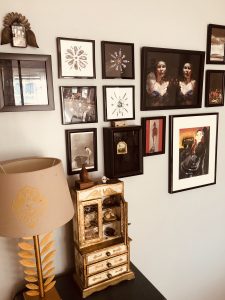
by Shasta Grant
Your collection begins with the title story, “Animal Wife,” about a girl whose mother has left. Her father holds a single feather from her mother’s feathered robe. The robe had been stored in a box that was bashed open, as it had no latch, no key. As the story unfolds, we learn that the daughter found the box and offered it to her mother. I don’t want to give too much away for those who haven’t read it but this action leads to the mother leaving. The collection ends with a story titled “Animal Wife Revisited” which is a prequel that tells the mother’s story. I thought this was such a clever way to begin and end the collection, setting up the themes and the way the stories move through girlhood, womanhood, and motherhood. Can you tell us about writing these two connected stories? Did you always know they would bookend the collection in this way?
“Animal Wife” was the first story I wrote in what became the collection Animal Wife. As I added stories, the theme of transformation emerged; specifically, the shifts from girlhood to adulthood, wifehood, motherhood, widowhood—the various roles women adopt throughout our lifetime.
“Animal Wife Revisited” was originally embedded in “Animal Wife” as the mother’s origin story within the broader story of Alex seeking her mother, who may or may not have transformed into a swan. In revision, I realized the embedded story wasn’t only unnecessary; it killed the mystery. When withheld from the reader, the mother’s origin story is all the more powerful because it leaves from for interpretation: Is the fairy tale real, or does Alex impose it upon her mother to make sense of her loss?
I cut the mother’s origin story from “Animal Wife” and moved it to the end of the collection as a standalone story. There, it resonates with “Animal Wife” without sapping its power and offers readers a new perspective on the fairy tale. The pieces can exist within the same story, about the same characters, or they can stand on their own as independent stories within the world of the book.
 I’m fascinated to learn that the mother’s origin story which we read in “Animal Wife Revisited” was originally part of “Animal Wife”! I’m curious if you’ve ever made one story into two standalone stories before or since (and now I want to revisit some of my own story drafts with this idea in mind)?
I’m fascinated to learn that the mother’s origin story which we read in “Animal Wife Revisited” was originally part of “Animal Wife”! I’m curious if you’ve ever made one story into two standalone stories before or since (and now I want to revisit some of my own story drafts with this idea in mind)?
Yes! I often Frankenstein stories, in part due to my inefficient drafting method. I tend to write and write and write and follow tangents without worrying too much about characters or plot. When I’ve written all I can, I organize what I have and see what emerges. That’s how I end up with big chunks of story that don’t fit together but function as independent pieces. The story “Beware the Undertoad” was originally part of a novel I’ve been struggling to write for about 10 years that shuttles between a character’s past and present until the past begins to intrude upon the present in unsettling and damaging ways. I crystallized the part of it that was working—the part that focused on the protagonist’s childhood—and developed it into a short story. “Six Roses” also originated as part of a longer piece about a group of girls told from first person plural point of view. It’s not a particularly efficient way of writing, I’ll admit, but I tend to have to write volumes to get to the heart of a story.
In “Vanishing Point” we meet Diana, a woman who creates a deer exosuit in secret at her university lab. Her dream is to live as a deer in the woods and the story follows her preparations and eventual move to the woods wearing the deer suit. In the acknowledgements you thank a number of writers for encouraging you to “go full deer” which I assume is a nod to this story. I’m always curious about the revision process and I’d love to know how this story changed as you revised it. Was there an earlier version that didn’t “go full deer”?
I revised “The Vanishing Point” at the Tin House Winter Writer’s Workshop with instructor Elizabeth McCracken and an amazing group of short story writers. The story draft that I workshopped with that group was fairly close to the final version, except that it didn’t—
as you point out—“go full deer.” I’ve adopted that phrase as shorthand for a craft lesson that’s become a guiding force for all of my stories that engage with the fantastical: To help readers buy into the fantastical, I ground my stories in precise, unique detail. Think about Harry Potter’s wizard battles: Rowling describes the wording of the spell, the flick of the wand, the way the wizard on the receiving end of the spell buckles in pain. We don’t need to know how the magic works to believe that it works.
In “The Vanishing Point,” I need readers to suspend their disbelief and go along with Diana’s reality, without getting hung up on practical questions about her deer suit or how she’s able to survive in the woods for months. So, I include just enough striking details for readers to feel as though they had the information they needed to believe in Diana’s world and experience.
Likewise, the believability of Diana’s life in the forest depends on the believability of her human body within a deer body. We learn how the deer suit rubs against her human body in uncomfortable ways, giving her blisters behind her heels, for example. I researched deer movements and sounds to imbue Diana with this knowledge and illuminate her human shortcomings, the elements of deer-hood she isn’t able to access.
Finally, there’s a critical scene in which Diana and a stag have sex. I shied away from this scene in the original draft, which made it uncomfortable in a bad way because it read as my discomfort, rather than Diana’s. Surprisingly, my critique group didn’t have a problem with Diana having sex with the stag—instead, they needed to know exactly how the bodies fit together to make the scene specific and believable within the world of the story. If I was going to include this scene, they said, I needed to fully explore how it happens and what it means. When I finally leaned into that scene, the story finally went “full deer,” along with Diana.
Tell us about your writing space. And what does a typical writing day look like for you?
 For the first time in my life, I have a small office, my very own “room of one’s own.” I’ve filled it with my books and journals and notebooks, pictures, strange postcards, and knickknacks. I fully intended to write in this space, but now that I’m working from home due to the pandemic, I tend to use my office for my day job—and as a recording studio for author events and my new podcast, Writer Mother Monster. (Shameless plug: Writer Mother Monster is a series of interviews with writer-moms devoted to dismantling the myth of having it all and offering other women writers with children solidarity, support, and advice. Learn more at WriterMotherMonster.com.)
For the first time in my life, I have a small office, my very own “room of one’s own.” I’ve filled it with my books and journals and notebooks, pictures, strange postcards, and knickknacks. I fully intended to write in this space, but now that I’m working from home due to the pandemic, I tend to use my office for my day job—and as a recording studio for author events and my new podcast, Writer Mother Monster. (Shameless plug: Writer Mother Monster is a series of interviews with writer-moms devoted to dismantling the myth of having it all and offering other women writers with children solidarity, support, and advice. Learn more at WriterMotherMonster.com.)
I sometimes write in my office, but more often I write everywhere but there. I write on the couch with my cat, at the dining room table, in my bedroom, and as I mentioned, in my car. Given that I’ve written the majority of my novel in my car, I should probably show you a photo of my old Subaru, but since my office is more interesting, we’ll go with that.
I don’t have a typical writing day. That’s something we talk a lot about on Writer Mother Monster. Before I became a mother, I had a strict routine: I’d wake up at 5 o’clock and write until I had to leave for work. Then, I’d write and edit on my lunch break. I also devoted weekend mornings to writing—especially Sunday, when my husband and I would camp out at a favorite coffee shop for hours drinking bottomless mugs of coffee. I miss that.
My routine went out the window once I became a mother. Every time I come close to having a new routine, my daughter hits a new milestone and it no longer works. I’ve learned to be okay with that and to be less precious about writing during specific times. I write whenever I can, and not every day.
When I need a solid chunk of time, usually for revision, I rent an Airbnb for a night. I’ll get there at check in and write until check out the next day. Since I’ve bought the space and committed the time, I’m able to sustain the focus I need to power through a lot of work.
What are you working on now?
I’m working on a novel. This time, I tried a more efficient approach to writing the first draft. In part, it was conscious, but it was also necessary because I no longer had those uninterrupted hours to draft by longhand and follow tangents. My biggest chunk of quiet time was in the car during my hour-long commute, so I started dictating to myself and then transcribing using the Otter app. That’s the way I outlined and then drafted my novel.
This was the first time I talked out a story to myself and charted its progression to figure out that it could be and should be a novel before I committed to writing hundreds of hundreds of pages. Of course, there were still plenty of parts that didn’t work, sections I had to rewrite, and characters I had to kill off, but the drafting process was a lot more efficient this time around.
The novel is loosely based on the Hans Christian Andersen story, “The Little Mermaid,” about a restless siren who becomes human only to find that she’s equally restless on land, trapped by domesticity. She runs off with her infant daughter and reinvents a failed mermaid burlesque. She performs as a siren until her daughter begins to push back against the fantasy world she’s created. A fun fact: For research, I attended the Sirens of the Deep Mermaid Camp at Weeki Wachee, Florida, where women have been performing as mermaids since 1946. I learned to swim—and dance!—in a tail. It was one of the strangest and most thrilling experiences of my life. I wrote about siren camp for Lit Hub.
___________________________
Lara Ehrlich’s work been published in literary magazines, including F(r)iction, Hunger Mountain, and SmokeLong Quarterly, and has been recognized with many awards and fellowships; most recently, Animal Wife received Red Hen Press’s Fiction Award, judged by New York Times-bestselling author, Ann Hood, who called the collection “sensual and intelligent, with gorgeous prose.” Animal Wife, which launched in Sept 2020, has been praised as “remarkable” by Lit Hub, who said “the collection is a standout in a season full of amazing new releases.” Lara is the host of the interview series Writer Mother Monster and she lives in Connecticut with her husband and daughter.
Shasta Grant is the author of the chapbook Gather Us Up and Bring Us Home (Split Lip Press, 2017). She was the 2016 SmokeLong Quarterly Kathy Fish Fellow and she won the 2015 Kenyon Review Short Fiction Contest. Her stories have appeared in Hobart, matchbook, MonkeyBicycle, wigleaf, and elsewhere.

 The core workshop of SmokeLong Fitness is all in writing, so you can take part from anywhere at anytime. We are excited about creating a supportive, consistent and structured environment for flash writers to work on their craft in a community. We are thrilled and proud to say that our workshop participants have won, placed, or been listed in every major flash competition. Community works.
The core workshop of SmokeLong Fitness is all in writing, so you can take part from anywhere at anytime. We are excited about creating a supportive, consistent and structured environment for flash writers to work on their craft in a community. We are thrilled and proud to say that our workshop participants have won, placed, or been listed in every major flash competition. Community works.